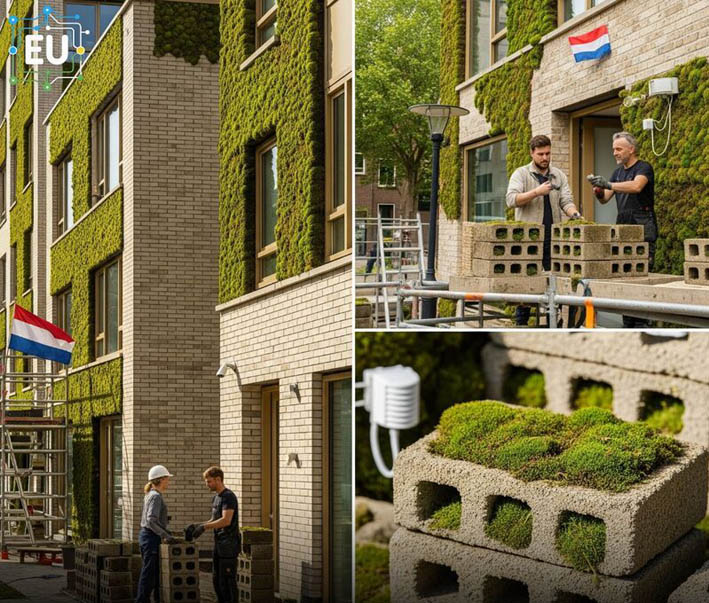By Aastha Khansaly
In Rotterdam, Dutch engineers are growing the future, literally.
A green-tech startup has developed “living bricks” that naturally grow moss, transforming buildings into vertical ecosystems that filter air, cool cities, and sequester carbon.

Why Moss?
Unlike decorative green walls or climbing vines, moss is a photosynthetic powerhouse that thrives in places other plants fail:
- It doesn’t need soil, only ambient moisture and shade.
- It tolerates extreme conditions like wind-exposed façades and concrete heat.
- It removes nitrogen dioxide, traps PM2.5, and absorbs CO₂, actively improving urban air quality.
Crucially, moss cools surfaces through evapotranspiration, reducing wall temperatures by up to 7°C in summer.
But here’s what’s often overlooked: Moss grows through surface colonisation, not roots. So to integrate it with the built environment, the surface itself must be engineered to mimic nature.
Why Bricks?
This is where the brilliance lies.
The outer shell of these “moss bricks” is designed with micropores and mineral blends that encourage native moss colonisation while resisting fungal decay.
These bricks pull moisture from the air (via capillary action and ambient humidity), triggering moss germination without irrigation or soil, and building self-sustaining green façades that require no maintenance.
This is not façade ornamentation. It's materials engineering meets urban ecology.
The Real Climate Argument: Surface Area Economics
We talk a lot about solar rooftops, vertical wind turbines, and green infrastructure but forget that cities are mostly made of vertical, unused surfaces.
Millions of square meters of façades sit idle, absorbing heat and re-emitting it into the urban atmosphere.
Now imagine if those same walls:
- Captured pollutants
- Absorbed carbon
- Cooled ambient temperatures
- Hosted native biodiversity without energy inputs, irrigation systems, or costly retrofits.
That’s what moss bricks unlock: decentralised, passive climate adaptation, baked into the materials of tomorrow.
Pilots & Potential
The Netherlands is now piloting moss bricks across schools, bus stops, and urban housing blocks , turning grey infrastructure into photosynthetic assets.
And this opens up new questions:
- Can moss bricks integrate with cooling or HVAC systems to passively precondition air?
- Could we design hybrid bricks that combine moss with solar skins, producing energy and capturing carbon?
- Can this approach extend to retaining walls, flyovers, or sound barriers, places vegetation usually can’t survive?
This is not about choosing between concrete and nature. It’s about fusing them, using materials that perform environmental services rather than just enclosing space.
The future doesn’t need to be built on nature. It can be built with it.
Aastha Khansaly is a GeoEnergy postgraduate from the University of Edinburgh, working at the intersection of geoscience, renewables, and climate impact.
 KEYFACT Energy
KEYFACT Energy